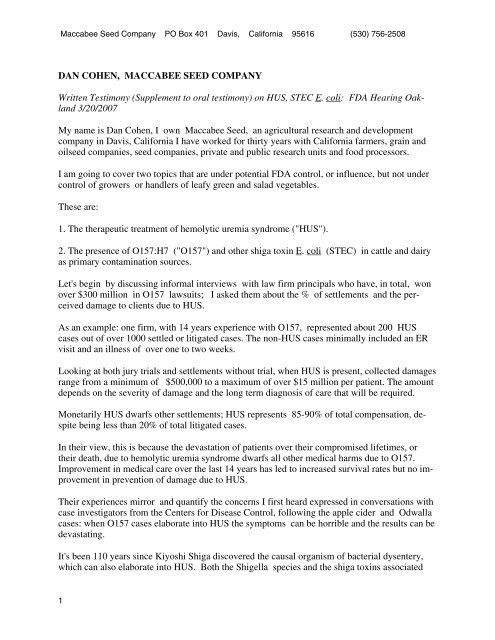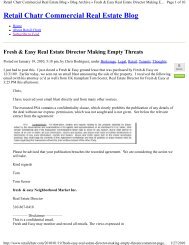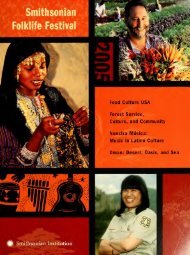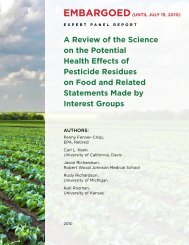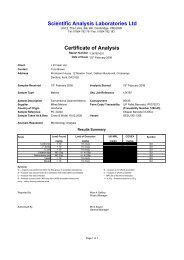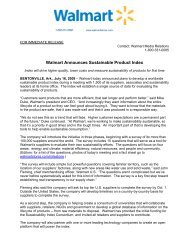Written Testimony - Perishable Pundit
Written Testimony - Perishable Pundit
Written Testimony - Perishable Pundit
You also want an ePaper? Increase the reach of your titles
YUMPU automatically turns print PDFs into web optimized ePapers that Google loves.
Maccabee Seed Company PO Box 401 Davis, California 95616 (530) 756-2508<br />
DAN COHEN, MACCABEE SEED COMPANY<br />
<strong>Written</strong> <strong>Testimony</strong> (Supplement to oral testimony) on HUS, STEC E. coli: FDA Hearing Oakland<br />
3/20/2007<br />
My name is Dan Cohen, I own Maccabee Seed, an agricultural research and development<br />
company in Davis, California I have worked for thirty years with California farmers, grain and<br />
oilseed companies, seed companies, private and public research units and food processors.<br />
I am going to cover two topics that are under potential FDA control, or influence, but not under<br />
control of growers or handlers of leafy green and salad vegetables.<br />
These are:<br />
1. The therapeutic treatment of hemolytic uremia syndrome ("HUS").<br />
2. The presence of O157:H7 ("O157") and other shiga toxin E. coli (STEC) in cattle and dairy<br />
as primary contamination sources.<br />
Let's begin by discussing informal interviews with law firm principals who have, in total, won<br />
over $300 million in O157 lawsuits; I asked them about the % of settlements and the perceived<br />
damage to clients due to HUS.<br />
As an example: one firm, with 14 years experience with O157, represented about 200 HUS<br />
cases out of over 1000 settled or litigated cases. The non-HUS cases minimally included an ER<br />
visit and an illness of over one to two weeks.<br />
Looking at both jury trials and settlements without trial, when HUS is present, collected damages<br />
range from a minimum of $500,000 to a maximum of over $15 million per patient. The amount<br />
depends on the severity of damage and the long term diagnosis of care that will be required.<br />
Monetarily HUS dwarfs other settlements; HUS represents 85-90% of total compensation, despite<br />
being less than 20% of total litigated cases.<br />
In their view, this is because the devastation of patients over their compromised lifetimes, or<br />
their death, due to hemolytic uremia syndrome dwarfs all other medical harms due to O157.<br />
Improvement in medical care over the last 14 years has led to increased survival rates but no improvement<br />
in prevention of damage due to HUS.<br />
Their experiences mirror and quantify the concerns I first heard expressed in conversations with<br />
case investigators from the Centers for Disease Control, following the apple cider and Odwalla<br />
cases: when O157 cases elaborate into HUS the symptoms can be horrible and the results can be<br />
devastating.<br />
It's been 110 years since Kiyoshi Shiga discovered the causal organism of bacterial dysentery,<br />
which can also elaborate into HUS. Both the Shigella species and the shiga toxins associated<br />
1
Maccabee Seed Company PO Box 401 Davis, California 95616 (530) 756-2508<br />
with HUS are named after him. About thirty years ago the genes associated with shiga toxin laterally<br />
transferred to E. coli strains. Unlike dysentery, coliform bacteria were generally perceived<br />
as indicator species for fecal contamination and as early warning signals for far more serious<br />
diseases.<br />
With hindsight, the appearance of shiga toxin E. coli should have been treated from the beginning<br />
as a new disease entity; and as a model case for appearance of a toxin-associated, highly<br />
pathogenic disease, with many of the same characteristics public health officials would have to<br />
deal with in an intentional contamination.<br />
In my view, the FDA should lead an interagency working group covering all aspects of contamination<br />
and outbreaks including therapeutics. This should include special funding and research on<br />
HUS therapies.<br />
[The only therapeutic I know of entering phase II clinical trials is a (monoclonal antibody) mAb<br />
combination antitoxin; research originally done at the Uniformed Services University, sublicensed<br />
and now controlled by a biotech company in Canada; it has Orphan Drug status in the<br />
US and EU.]<br />
For the leafy green and salad industries, better therapeutics for HUS would mean that growers,<br />
handlers and consumers would be exposed to the risk of a greatly reduced harm.<br />
The FDA-led working group should also conduct a complete review of off-site health dangers<br />
posed by practices in the production of meat and milk in the<br />
cattle and dairy industries. Cattle and dairy have been repeatedly identified as the principal reservoir<br />
of O157 and other shiga toxin E. coli strains of concern. They have also been reported to<br />
be important origins and reservoirs of multiple antibiotic resistances of concern to human health.<br />
Both reservoirs should be identified and reduced.<br />
For the leafy green and salad industries, a reduction in the sources and reservoirs of contamination<br />
would mean a much smaller risk of causing a harm. They would have a safer environment in<br />
which to operate. An environment, for example, with uncontaminated irrigation water.<br />
Better therapeutics for HUS combined with reduction in the reservoirs and sources of contamination<br />
would result in a reduced risk of a greatly reduced harm. I think improvements in growing<br />
and handling practices will be more effective in a lower risk environment.<br />
Thank you for hearing my testimony.<br />
[Both of these risk reductions are scale neutral; they would benefit farm operations of all sizes<br />
from Hmong farmers with under 10 acres, to organic farmers with 2-300 acres, to the very large<br />
operations with tens of thousands of acres and multiple locations.<br />
Some proposed changes in food safety regulation are not scale neutral, and may adversely affect<br />
smaller farmers far more significantly.<br />
2
Maccabee Seed Company PO Box 401 Davis, California 95616 (530) 756-2508<br />
I was partly motivated to testify today by concerns expressed by NRCS (Natural Resource Conservation<br />
Service) and RCD (local Resource Conservation District) staff and local farmers. Their<br />
fear is that some of the food safety proposals attempt to create a sterile farm landscape ("farmscape"),<br />
which would undo decades of work on farms as environmental benefits. I have the<br />
same concerns.<br />
An approach to the food safety issue was developed by the Community Alliance with Family<br />
Farmers (CAFF) and summarized in testimony by Judith Redmond before the California Senate<br />
and Assembly Agriculture Committees, Joint Session, February 27, 2007. I agree with their conclusions,<br />
reached independently of my own work (available at www.caff.org).<br />
In my view, the outbreak record, and testimony at three California legislative hearings suggests<br />
the following priorities:<br />
1. First, review or clean-up the major operations in the processed leafy green and salad industry<br />
from planting through packaging. This includes ensuring standard food safety procedures for<br />
processing and packaging.<br />
2. Second, review or improve safety in the transportation of processed leafy greens and salads to<br />
the retail level; including records of temperature controls.<br />
3. Third, review or improve the safety of the actual packaging ("bags"), as an environment for<br />
potential microbial growth. This would include checking the adequacy of safety of sell-by or<br />
use-by dates.<br />
4. Fourth, review or clean-up operations in the Salinas valley, and other regions where there are<br />
found to be area-wide issues and concerns affecting most growers.<br />
5. Fifth, provide information, testing and cheap accurate testing equipment for smaller farm operations<br />
to use to enhance their food safety.<br />
There are great benefits to U.S. consumers from the convenience of prepared, packaged fresh<br />
vegetable from baby carrots to salad mixes. There are also great benefits from the fresh fruits and<br />
vegetables of local producers in farmers markets, coops and regional or specialized markets.<br />
Food safety regulations designed for large national producers may end up harming local producers,<br />
even when they are ineffective.]<br />
[Statements contained in brackets will not be presented in oral testimony]<br />
Dan Cohen<br />
Maccabee Seed Company<br />
PO Box 401 Davis, CA 95617<br />
(530) 756-2508<br />
3


